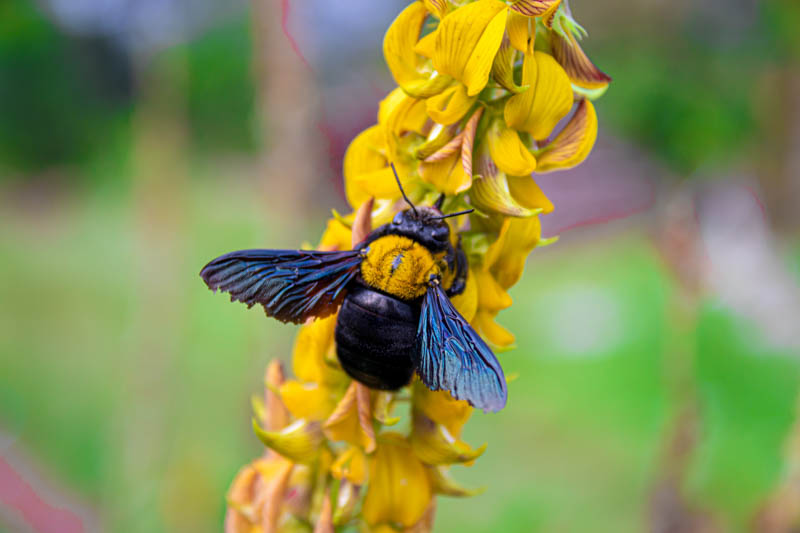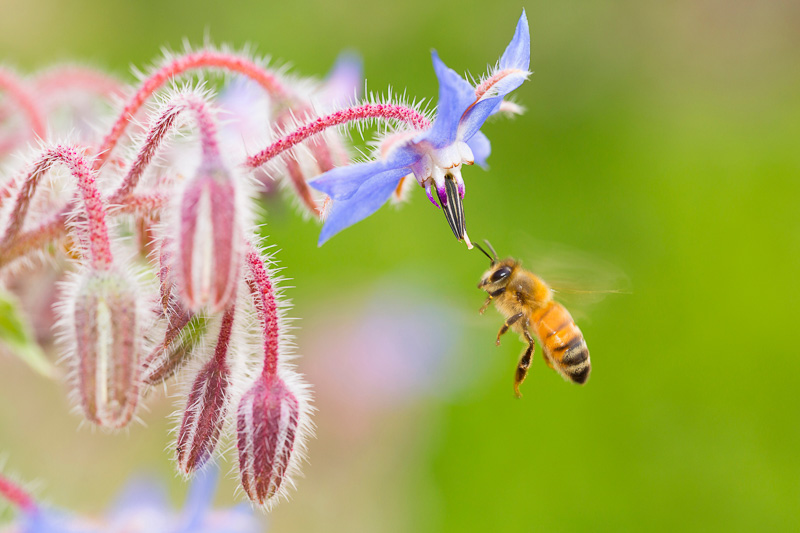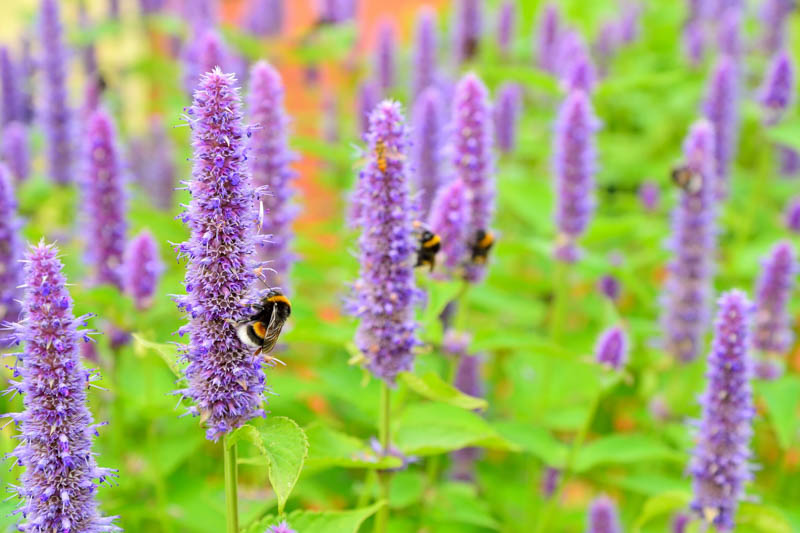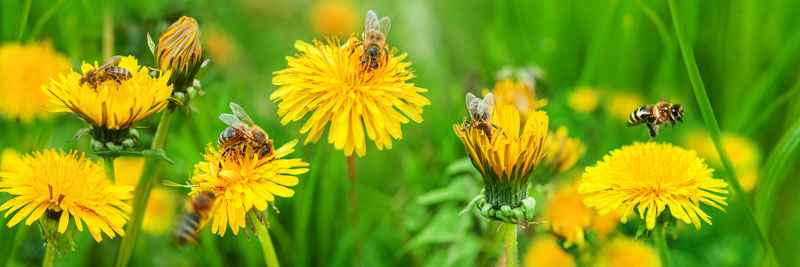In creating a bee-friendly garden, we don't just offer bees a sanctuary; we also enrich our lives, our plates, and our environment. The hum of bees becomes a symphony of life, reminding us that even in our backyards, we can make a world of difference.
Bees, the tiny powerhouses of nature, punch well above their weight when it comes to their ecological significance. Their relentless foraging is more than a quest for nectar; it’s a dance of life that ensures the survival and prosperity of many plants and, by extension, the animals that depend on them. Let’s delve into why these insects are indispensable, which ones you’d want to attract, and the urgency of cultivating bee-friendly gardens.
Bees are essential for several compelling reasons:
Pollination: Bees play a vital role in pollinating the flowers of many of the plants that make up the world’s food supply. This process is crucial for the reproduction of these plants. Without bees, many fruits, vegetables, and nuts would become scarce or disappear altogether.
Biodiversity: Through their pollination, bees support the growth of trees, flowers, and other plants, which serve as food and habitat for various wildlife. This chain of pollination promotes biodiversity within ecosystems.
Food Supply: A significant portion of our diet comes directly or indirectly from pollinated plants. This includes not only fruits and vegetables but also the food animals eat, which, in turn, becomes our meat.
Economic Impact: The agricultural sector heavily relies on bees for pollination. Their decline can lead to decreased crop yields, affecting the livelihoods of farmers and leading to increased food prices.
Medicine: Many of the plants bees pollinate are used in natural medicines.
Environmental Indicators: Bees can serve as a bio-indicator of environmental conditions. A declining bee population can be an early warning sign of higher pollution levels or other environmental problems.
Honey Production: Besides pollination, honeybees produce honey, wax, and propolis, which humans have harvested for various uses for thousands of years.
While the honeybee often hogs the limelight, there are numerous bee species, each with unique qualities and preferences.
Attract Because: Honeybees are prolific pollinators and honey producers. A garden buzzing with honeybees ensures continuous pollination and increased yields.
Why Attract: They support plant diversity, yield honey, and enhance flower fertilization.
Attract Because: Bumblebees can “buzz pollinate,” a process where the bee grabs onto a flower and vibrates its flight muscles, causing pollen to be released from the flower’s anthers. This makes them invaluable for certain plants like tomatoes, peppers, eggplants, blueberries, kiwi.
Why Attract: Their unique pollination method aids specific plants, and their presence indicates a healthy ecosystem.
Attract Because: Mason bees are solitary, peaceful, and hyper-efficient pollinators, often outperforming honeybees in fruit tree pollination. They are recognized for their impressive pollination skills, especially in cooler and wetter conditions where other bees might not be as active.
Why Attract: They’re non-aggressive, excellent for fruit tree yields, and don’t require hive maintenance. They don’t produce honey but are peaceful and rarely sting.
Attract Because: Leafcutter bees are solitary bees known for their distinctive behavior of cutting neat circles or ovals out of leaves to construct their nests. While not as commonly recognized as some other bee species, they are efficient pollinators that can play a crucial role in plant reproductive processes. Leafcutter bees are particularly good at pollinating alfalfa, blueberries, carrots, onions, legumes (beans, peas)or wildflowers.
Why Attract: Their pollination aids garden growth. While they do cut leaves for nest-making, the overall benefit they provide to gardens and crops in terms of pollination far outweighs the minor aesthetic damage they might cause to plants.
Attract Because: Carpenter bees are large, robust bees known for their habit of boring into wood to create nesting sites. Despite sometimes being viewed as pests due to their nesting behavior, carpenter bees play a valuable role as pollinators. Carpenter bees are great pollinators for open-faced flowers. Passionfruit, tomatoes, eggplants, peppers, and various wildflowers benefit from the pollination services of carpenter bees.
Why Attract: They enhance pollination rates, support plant diversity, and naturally process dead wood.
Supporting Declining Bee Populations: Alarmingly, many bee species are in decline due to habitat loss, pesticides, and climate change. Gardens can act as mini refuges, offering essential resources.
Enhanced Garden Yields: For gardening enthusiasts, attracting bees boosts the yield and quality of fruits and flowers. The more bees, the better the pollination.
Environmental Balance: Gardens that welcome bees support a balanced ecosystem. These gardens often use fewer pesticides and encourage other beneficial insects and wildlife.
Aesthetic and Sensory Appeal: A bee-friendly garden buzzes with life. The sights and sounds of bees and other pollinators can enhance the sensory experience of any garden, making it a lively, therapeutic space.
Educational Opportunities: Such gardens can be educational hubs, offering insights into the world of bees, the importance of pollination, and the intricacies of ecosystems. It’s a fantastic way for both kids and adults to connect with nature.
 Violet Carpenter Bee (Xylocopa violacea)
Violet Carpenter Bee (Xylocopa violacea)
Before we delve into the garden specifics, understanding bee basics is crucial. Bees require three primary things:
Most bee-favored plants thrive in full sun, which is a minimum of six hours of direct sunlight daily. Bees themselves are more active in sunny spaces. When planning or enhancing your garden, aim to position the majority of plantings in sunlit areas.
The choice of flowers is paramount. Here’s what to keep in mind:
Recommended Flowers for Bees:

Bee attracted by a Borage flower (Borago officinalis)
Double-petal varieties might be visually appealing but don’t offer as much nectar or pollen. Simple, traditional flower varieties are more nutritious.
Bees are more likely to be attracted to swathes of land with the same flower rather than individual plants. Grouping the same plants together helps bees expend less energy foraging.
Many herbs, like mint, sage, rosemary, and thyme, are bee-friendly. Plus, they have culinary and medicinal uses for us.
Climbing plants, like honeysuckle and jasmine, are great for bees and can be a space-saver.
 Bumblebees searching for nectar on the flower spikes of Kreant Mint (Agastache rugosa)
Bumblebees searching for nectar on the flower spikes of Kreant Mint (Agastache rugosa)
A shallow water source is essential. Consider a birdbath with stones where bees can land, or a shallow dish with pebbles to give them safe sipping spots. Refresh the water regularly.
While many bees burrow in the ground or in wood, others utilize the hollow stems of last season’s plants. Leaving a patch of garden untidy in the winter can provide shelter. You can also purchase or make a bee hotel.
Synthetic pesticides, especially neonicotinoids, are harmful to bees. If you must use pesticides, opt for organic or natural varieties and apply them in the evening when bees are less active. Always follow label directions.
Allowing clover and dandelions to grow in your lawn provides more foraging areas. These “weeds” are also good for the soil and require less mowing.

Bees pollinating dandelion flowers
Spread the word about the importance of bees. The more bee-friendly gardens, the better for the environment.
A bee-friendly garden is a win-win. Bees get the necessary sustenance, and gardeners enjoy lush blooms, better yields in fruit and vegetable gardens, and the joy of supporting vital pollinators. By integrating bee-friendly practices and plantings, we can each play a part in ensuring a healthier, more biodiverse environment. So, roll up your sleeves and start creating that buzzing haven!
| Genus | Allium, Aster, Penstemon, Nepeta, Pulmonaria, Calendula, Achillea, Agastache, Dahlia, Digitalis, Crocus, Cosmos, Hamamelis, Lavandula, Monarda, Lonicera, Zinnia, Solidago, Eryngium, Echinacea, Echinops, Sedum |
|---|---|
| Attracts | Bees |
| Genus | Allium, Aster, Penstemon, Nepeta, Pulmonaria, Calendula, Achillea, Agastache, Dahlia, Digitalis, Crocus, Cosmos, Hamamelis, Lavandula, Monarda, Lonicera, Zinnia, Solidago, Eryngium, Echinacea, Echinops, Sedum |
|---|---|
| Attracts | Bees |
Create a membership account to save your garden designs and to view them on any device.
Becoming a contributing member of Gardenia is easy and can be done in just a few minutes. If you provide us with your name, email address and the payment of a modest $25 annual membership fee, you will become a full member, enabling you to design and save up to 25 of your garden design ideas.
Join now and start creating your dream garden!
Create a membership account to save your garden designs and to view them on any device.
Becoming a contributing member of Gardenia is easy and can be done in just a few minutes. If you provide us with your name, email address and the payment of a modest $25 annual membership fee, you will become a full member, enabling you to design and save up to 25 of your garden design ideas.
Join now and start creating your dream garden!